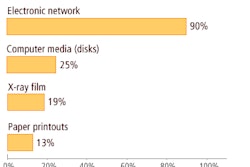PROVIDENCE, RI - Using a two-tier imaging information technology (IT) support staffing model that blends the experience levels of personnel offers a high level of flexibility and improved service, according to researchers from Brigham and Women's Hospital in Boston.
With this model, "we found significantly improved response times to help-desk tickets, great communication, and have significantly improved quality of the follow-up involved," said Maria Damiano. She spoke during a scientific session Saturday at the 2007 annual meeting of the Society for Imaging Informatics in Medicine (SIIM).
Brigham and Women's medical imaging IT (MIIT) program is a multi-institutional, multidisciplinary effort, Damiano said. In addition, it's multifunctional, encompassing RIS and PACS, computerized physician order entry (CPOE), enterprise scheduling, speech recognition reporting systems, decision support, automatic clinician alerts, and enterprise image viewing, as well as quality, patient safety, and process improvement initiatives.
Brigham and Women's Hospital is a 750-bed academic medical center that has a staff of 12,000, with 2,800 nurses and 3,000 physicians on the main campus. Nearly all the clinical staff have access to digital images and reports, Damiano said.
Technology deployment in medical imaging areas is handled in the context of performance improvement using change-management methodologies, she said.
In this environment, MIIT support requires a broad knowledge across all applications and a depth of knowledge of each application. The institution wanted to have 24/7 seamless operation in all clinical areas, but faced the challenge of optimizing scheduling and training of staff to provide for this goal.
Some support staff had broad knowledge across all applications but not much depth of knowledge on each application, while others had very in-depth knowledge on specific applications but weren't sure how to connect it or interface with other applications, Damiano said.
"Our challenge was to provide training so that we could bring these two groups, what had been disparate groups, to bring these groups together so that they could feed off one another and cross-train one another," she said. "So the challenge was to optimize the scheduling of staff and training of staff to provide this goal of seamless operations."
The MIIT support program has 31 FTEs, which provide help-desk support (technical support and applications support), as well as technology deployment, process improvement, and patient safety initiatives, Damiano said.
To create the staffing plan, the institution created a grid of required support competencies, and based on that developed a staffing plan. The first step involved creating two shifts for the primary support staff, allowing for expansion of immediate on-call coverage from 7 a.m. to 7 p.m., she said.
In this new model, a first tier of support is provided by staff members who have a broad knowledge of each of the systems used, according to Damiano. Each day, three staff members are scheduled to cover one four-hour block of time (7 a.m. to 11 a.m., 11 a.m. to 3 p.m., and 3 p.m. to 7 p.m.) during which they primarily field help-desk calls.
"Each of these three individuals works five blocks per week (when) they're assigned to actually carry the pager and respond to help-desk calls," she said. "What that accomplished is, if at 11 o'clock they were working on two calls they needed to finish up, the next person took the pager and started to respond to the other problems that might have arisen. Our help desk reports that response time improved significantly."
The second tier of support includes staff that have a very in-depth knowledge of specific applications, and of these staff members, two are scheduled for one four-hour block of time (8 a.m. to noon and 12:30 p.m. to 4:30 p.m.) each day. These staff were designed to provide backup to the first-tier support staff, according to Damiano.
Each staff tier also took on cross-training initiatives, in which the first tier was able to gain more in-depth training on new applications from the second-tier staff. In turn, the second-tier staff was also able to learn about other applications from the first-tier staff. Managers also created didactic sessions on new applications, which personnel could review during downtime, according to Damiano.
Today, the model has evolved slightly. One manager now manages both groups, and the second tier doesn't have a structured schedule as before, she said.
"What has evolved is the very natural availability of the second-tier staff to immediately support the first-tier staff," Damiano said.
The MIIT support plan has yielded a number of benefits, including a greater depth of knowledge for first-tier support staff and a broader base of knowledge for second-tier support staff, she said.
The plan also provided for significant increases in flexibility in staffing, as well as significantly improved help-desk ticket follow-up, Damiano said.
"It's a very practical approach," she said.
By Erik L. Ridley
AuntMinnie.com staff writer
June 9, 2007
Related Reading
Imaging informatics shaped by evolving role, June 7, 2007
PACS administrator certification program gets under way, May 30, 2007
Florida, DoD to develop HIT exchange, April 6, 2007
Regulatory carve-outs hope to spur HIT growth in U.S., February 28, 2007
Washington advocates healthcare information banks, December 6, 2006
Copyright © 2007 AuntMinnie.com



















